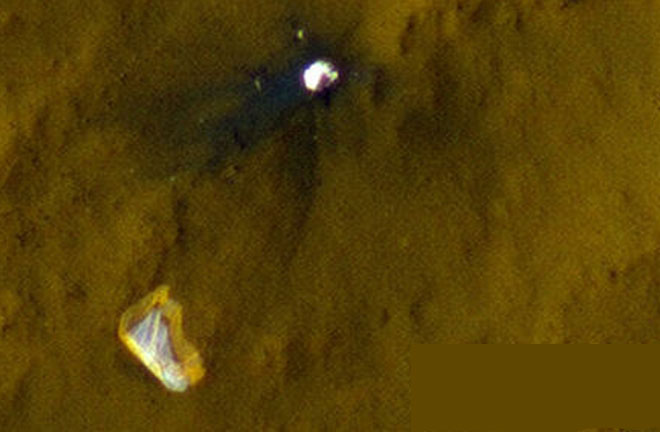.

When NASA’s rover Curiosity entered the Martian atmosphere to begin its famous “7 minutes of terror,” one component of its entry, descent and landing (EDL) included the deployment of a huge parachute to capture the thin Mars air to aid its rapid deceleration. Shortly after landing inside Gale Crater on Aug. 5, 2012, NASA’s orbiting Mars Reconnaissance Orbiter managed to photograph not only the parachute, but also the backshell, heat shield, skycrane and counterweights.
Now, the team managing one of the MRO’s instruments — the High-Resolution Imaging Science Experiment (HiRISE) — have released a series of photos of Curiosity’s parachute over the course of five months.
.

Mars’ atmosphere can be up to 1,000 times thinner than Earth’s, so although the red planet experiences global dust storms and small-scale dust devils, the Martian wind at its most fierce won’t exactly knock you off your feet. But for Curiosity’s discarded parachute, the wind is strong enough to cause it to flap around.
“Sometime between September 8, 2012 and November 30, 2012, there was a major change in which the parachute extension to the southeast (lower right) was moved inward, so the parachute covers a smaller area,” observes Alfred McEwen, planetary geologist at the University of Arizona in Tucson and HiRISE principal investigator. “In the same time interval some of the dark ejecta around the backshell brightened, perhaps from deposition of airborne dust.”
McEwen also points to another windy event between Dec. 16, 2012 and Jan. 13, 2013, which caused the parachute to shift to the southeast.
Apart from being a minor curiosity and a lovely reminder that we have satellites capable of observing temporal weather events on another planet, these flapping events may help explain why the Viking landers’ parachutes still remain visible from orbit since their landing in 1976 — windy events dust-off the bright parachute material. Also, the motion of a large piece of fabric on the surface of Mars provides a direct view of the weather conditions on the ground, much like a windsock on an airfield provides pilots with general information about wind direction and speed.
“The parachute’s suspension lines were made from Technora, with a fiber similar to Kevlar,” adds McEwen. “The color is a creamy yellow, which is why they are not visible in the images such as those in the Phoenix lander descent image which were white.”
Quelle: Discovery News
5923 Views
